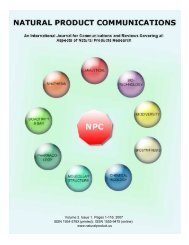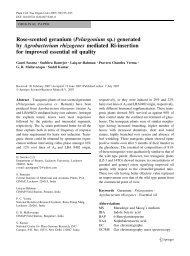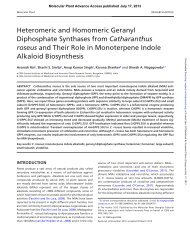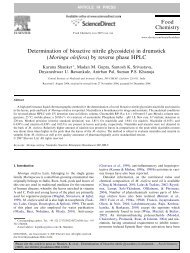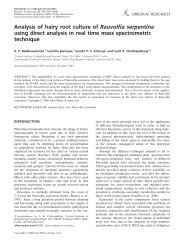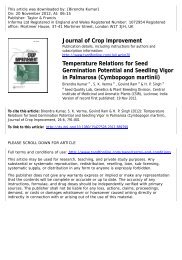Recent advances in plant hepatoprotectives - CIMAP Staff - Central ...
Recent advances in plant hepatoprotectives - CIMAP Staff - Central ...
Recent advances in plant hepatoprotectives - CIMAP Staff - Central ...
Create successful ePaper yourself
Turn your PDF publications into a flip-book with our unique Google optimized e-Paper software.
RECENT ADVANCES IN PLANT HEPATOPROTECTIVES<br />
*<br />
759<br />
studies also showed its liver protective and detoxify<strong>in</strong>g actions <strong>in</strong> children with hepatitis and<br />
jaundice. In India, it is used as a s<strong>in</strong>gle drug <strong>in</strong> the treatment of jaundice <strong>in</strong> children, 135 and British<br />
researchers showed that children treated with Phyllanthus extract for acute hepatitis could return the<br />
liver function to normal with<strong>in</strong> 5 days. Also, Ch<strong>in</strong>ese researchers found its liver protective actions <strong>in</strong><br />
adults affected with chronic hepatitis. 136,137 Both phyllanth<strong>in</strong> and hypophyllanth<strong>in</strong> protect liver<br />
aga<strong>in</strong>st carbon tetrachloride and galactosam<strong>in</strong>e-<strong>in</strong>duced cytotoxicity <strong>in</strong> primary cultured rat<br />
hepatocytes. 138 These lignans also protect liver damage <strong>in</strong>duced by alcohol, and normalized a ‘‘fatty<br />
liver’’ condition.<br />
D. Mode of Action<br />
The liver protective effect of phyllanthus extract was due to free radical scaveng<strong>in</strong>g activity. 139 It can<br />
scavenge superoxides and hydroxyl radicals and hence, <strong>in</strong>hibit lipid peroxidation. 140 Phyllanth<strong>in</strong> was<br />
reported to exhibit antigenotoxic properties. 141<br />
E. Toxicity and Side Effects<br />
There are very few published reports regard<strong>in</strong>g the toxicity of phyllanth<strong>in</strong> and hypophyllanth<strong>in</strong>.<br />
However <strong>in</strong> a recent report 142 rats fed with the aqueous leaf extract of P. amarus showed toxic effects<br />
on the hematological and serum biochemical parameters like decrease <strong>in</strong> RBC count, packed cell<br />
volume, Hb concentration and <strong>in</strong>crease <strong>in</strong> WBC count apart from other effects on liver, testis, kidney,<br />
and weight loss. Hence, it was recommended that extreme caution should be exercised <strong>in</strong> the use of<br />
this <strong>plant</strong>.<br />
F. Future Prospects<br />
<strong>Recent</strong>ly, Phyllanthus species has ga<strong>in</strong>ed <strong>in</strong>terest considerably due to good therapeutic potential for<br />
many diseases. Extensive phytochemical, pharmacological and cl<strong>in</strong>ical studies have been done to<br />
establish it as a hepatoprotective agent. However, there are many aspects, which need to be explored<br />
like well-controlled double bl<strong>in</strong>d cl<strong>in</strong>ical trials us<strong>in</strong>g large sample size (large number of patients)<br />
for their (phyllanth<strong>in</strong> and hypophyllanth<strong>in</strong>) efficacy and toxicity, a complete analysis of mode of<br />
action, etc.<br />
7. GLYCYRRHIZIN<br />
A. Introduction<br />
Glycyrrhiz<strong>in</strong> (15), is a major and active constituent of roots of Glycyrrhiza glabra (Family:<br />
Legum<strong>in</strong>acae) commonly known as Indian licorice. It is a most commonly used herb <strong>in</strong> the traditional<br />
medic<strong>in</strong>e system of India, Ch<strong>in</strong>a and other countries. Licorice is an under shrub, usually of 2 m height,<br />
erect, perennial <strong>plant</strong> with light, gracefully spread<strong>in</strong>g p<strong>in</strong>nate foliage and dark green lanceolate<br />
leaflets that hang down at night with violet to lavender color flower. Licorice is used for flavor<strong>in</strong>g,<br />
sweeten<strong>in</strong>g candies and medical remedies. Licorice is a very sweet (30–50 times as potent as table<br />
sugar) herb that detoxifies and protects liver. 143<br />
B. Chemistry<br />
Chemically, glycyrrhiz<strong>in</strong> (Fig. 11) is a triterpenoid sapon<strong>in</strong> named as (3b,20b)-20-carboxy-11-oxo-<br />
30-norolean-12-en-3-yl-2-O-b-D glucopyranosyl-a-D-glucopyranoiduronic acid (15). Standardization<br />
of licorice is done based on glycyrrhiz<strong>in</strong> content. Enzymatic hydrolysis of glycyrrhiz<strong>in</strong> us<strong>in</strong>g<br />
glucuronidase yields glycyrrhet<strong>in</strong>ic acid as an aglycone.<br />
Medic<strong>in</strong>al Research Reviews DOI 10.1002/med




